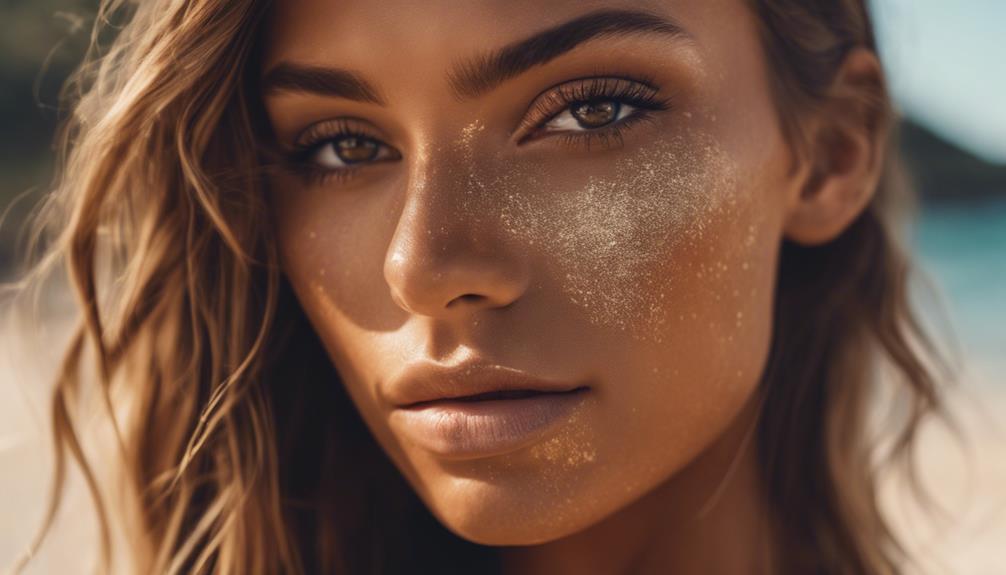So, you've just tanned but now you're rocking that funky post-tan odor—what gives? This scent comes from bacteria getting cozy on your skin, especially with all that warmth and sweat. Yep, UV rays amp up bacteria too! To keep that odor from crashing your vibe, shower before and after tanning, and don't skip moisturizing. Exfoliating helps too, keeping your skin fresh. And hey, snag some antibacterial lotions or fragrant body washes to mask those smells. Everyone's skin's a bit different, so your scent might not match anyone else's! Curious about the best products to use? Stick around for more!
Key Takeaways
- Post-tan odor results from bacteria thriving on warm, sweaty skin and increased UV light activity.
- Showering before and after tanning helps remove sweat and bacteria, reducing odor.
- Antibacterial lotions and high-quality moisturizers can effectively combat and minimize post-tan scents.
- Individual skin chemistry and the quality of tanning products influence the intensity and duration of tan odor.
Causes of Post-Tan Odor
Post-tan odor (ATO) mainly arises from bacteria thriving on your skin when warmth and sweat combine during tanning sessions.
You know that feeling when you step out, looking golden but feeling a bit… off? That's the bacteria partying it up on your skin!
UV lights crank up their activity, making them super energetic. When heat and sweat mix, they create that infamous aroma you'd rather avoid.
Plus, your skin's defensive reactions to those UV rays can add to the scent.
And let's not forget, everyone's skin's chemistry is a bit different, so we all might get unique scents.
Importance of Hygiene

Maintaining proper hygiene is essential for keeping that fresh look and minimizing any unwanted tan odor. Let's face it, nobody wants to walk around smelling like a sweaty sock after a tanning session!
Keeping clean helps your skin stay healthy and odor-free. Here are three simple tips to help you out:
- Shower Before and After: Wash away sweat and bacteria before you tan, and rinse off post-tan to keep things fresh.
- Moisturize Regularly: Hydrated skin not only feels good but also fights off that pesky odor.
- Exfoliate: Scrubbing away dead skin cells helps eliminate the bacteria that cause unwanted smells.
Effective Odor Control Products

Choosing the right products can make a huge difference in controlling tan odor and keeping your skin feeling fresh. Think about it: who wants to smell like a sweaty gym sock after a tanning session?
Antibacterial lotions are your best buddies here; they fight off those pesky odor-causing bacteria. Don't forget high-quality after-tan moisturizers, which hydrate your skin and help keep that smell at bay.
You could also try vanilla or citrus-scented goodies—who doesn't love a little zing? And let's not overlook deodorizing soaps or scented body washes; they can be lifesavers for masking any lingering scents.
With the right products in your arsenal, you'll be on your way to smelling amazing post-tan!
Factors Affecting Odor Duration

Several factors influence how long that tan odor lingers, including your skin's reaction to UV rays and the quality of the tanning products you use.
If you're sweating, guess what? Bacteria are throwing a party on your skin, and that's not a good time for your nose!
Here are three key factors to keep in mind:
- Skin Chemistry: Everyone's skin is different, which means your unique chemistry can produce varying odors.
- Tanning Product Quality: High-quality lotions can help reduce that funky smell compared to cheaper alternatives.
- Heat and Sweat: The more you sweat, the longer that tan odor hangs around, thanks to our old friends, bacteria.
Preventative Measures

To keep that post-tan odor at bay, apply a tanning lotion with antibacterial properties before you hit the tanning bed. Seriously, it's like giving your skin a shield against those pesky bacteria that love to party in sweaty spots!
After tanning, don't skip the shower—wash away any lingering bacteria and sweat. You'll feel fresher, trust me!
And hey, don't forget to moisturize afterward; it helps keep your skin hydrated and can minimize any funky smells.
Exfoliating regularly is also a game changer, as it removes dead skin and the bacteria hiding there.
Oh, and if you use a fragrant body wash, especially citrusy ones, you'll be smelling like a summer day instead of a sweaty sock! How awesome is that?
Frequently Asked Questions
Can Diet Affect Post-Tan Odor Intensity?
Yes, your diet can impact post-tan odor intensity. Foods like garlic, onions, and spicy dishes can elevate body odor. Staying hydrated and consuming fresh fruits may help minimize any unpleasant scents after tanning.
How Long Does Post-Tan Odor Typically Last?
Post-tan odor typically lasts a few hours to a couple of days, depending on your skin type and hygiene practices. Showering promptly and using antibacterial products can help reduce the duration considerably.
Are Certain Skin Types More Prone to Tan Odor?
Imagine a garden; some flowers flourish while others wilt. Your skin type can influence how easily it attracts post-tan odor. Oily or sensitive skin might be more prone, so understanding your skin helps you stay fresh.
Does Water Temperature Impact Post-Tan Odor During Showers?
Water temperature does impact post-tan odor during showers. Warm water can open pores, releasing trapped bacteria and sweat, while cooler water helps close pores, reducing odor intensity. So, choose your shower temperature wisely for freshness!
Can Fragrances in Tanning Products Worsen Odor?
Fragrances in tanning products can sometimes worsen odor, especially if they interact with your skin chemistry or sweat. It's best to choose lightly scented or unscented products to help maintain a fresher post-tan experience.
Conclusion
So, there you have it! Tackling after-tan odor doesn't have to be a mystery anymore.
Did you know that nearly 70% of people experience some form of post-tan smell? That's a lot of folks in the same boat!
By staying fresh with good hygiene and using the right products, you can enjoy your tan without the funky aftermath.
Remember, a little prep goes a long way toward keeping you feeling confident and odor-free.
Happy tanning!










